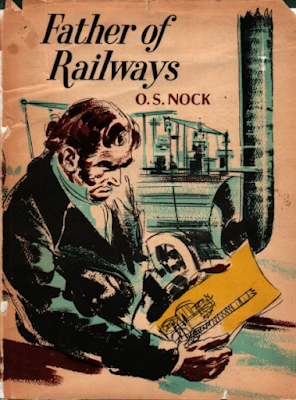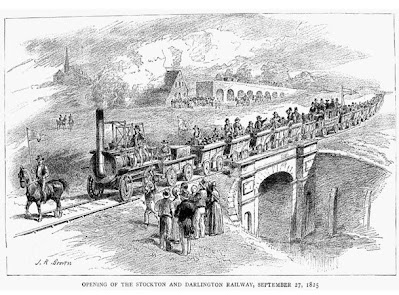George Stephenson - Father of the Railways
 |
| George Stephenson 'Father of the Railways' |
Northumbrian George Stephenson the railway pioneer is renowned as the "Father of The Railways".
He was born in Wylam, 9th June 1781, the second child of Robert and Mabel Stephenson. Robert worked as a firemen on a pumping engine at Wylam Colliery. The house in which George was born, High Street House, was adjacent to the Wylam Wagonway.
The family were poor, so there was no money for education. Aged 8, George started work keeping cows off the Wylam Wagonway. His mechanical career started as an engineman at Newburn Colliery in 1798. George also took the opportunity to start educating himself, being illiterate until he was 18 .
In 1802 he married Frances Henderson and they moved to Willington Quay, where George worked as an engine brakeman on the winding gear at Ballast Hill. Son Robert, who would also become a renowned engineer, was born in 1803.
The Stephenson family moved to West Moor, Killingworth, in 1804 where George was employed as a brakeman at the colliery. Sadly in 1806, George's wife and daughter died. He briefly worked in Scotland, but returned back to West Moor.
Whilst working at the colliery his mechanical skills began to be appreciated and he was promoted to engine wright, responsible for maintaining and repairing all the colliery engines. As a result of this position he became an expert in steam machinery.
It was not only steam machinery which George Stephenson devoted his skills to. He developed a miners safety lamp which provided light without exposing a naked flame, vital to avoid gas explosions down a mine.
George Stephenson's expertise with static steam engines led him to start experimenting with moving engines after observing their use in local collieries.
His first locomotive was constructed in 1814 in the colliery workshop behind Stephenson's home, Dial Cottage. The engine, called Blücher (after the Prussian general von Blücher who supported the British at the Battle of Waterloo) hauled coal waggons on the Killingworth colliery railway.
Stephenson would continue to improve his designs and it is thought he built 16 locomotives at Killingworth, for use in that colliery or for the Hetton colliery railway.
In 1820 Stephenson was hired to build the 8-mile (13-km) Hetton colliery railway in which opened in 1822.
When constructing his locomotives and railways Stephenson used a gauge (distance between the lines) of 4 feet 8 1⁄2 inches (1,435 mm), which would become the standard gauge for railways throughout the world.
A parliamentary bill was passed in 1821 for the building of a railway between Stockton and Darlington Railway . In the same year George Stephenson, assisted by his son Robert began surveying the route and construction began.
In 1823 Robert Stephenson founded a locomotive manufacturing works in Forth Street, Newcastle. The company, Robert Stephenson and Company was the first in the world to formed specifically to build railway engines.
The first locomotive built at the Forth Street works was named Locomotion which was destined for the Stockton and Darlington Railway.
The Stockton and Darlington Railway (S&DR) opened on 27 September 1825, Locomotion hauling coal and goods waggons plus a passenger carriage to carry dignitaries, on the inaugural journey.
 |
| Opening Stockton and Darlington Railway 27 Sep 1875 |
 |
| Locomotion Stockton and Darlington Railway 27 Sep 1875 |
The Liverpool and Manchester Railway Company was founded on 20 May 1824 and George Stephenson was appointed principal engineer.
After initial problems in establishing the route which resulted in the Bill to authorise the railway being rejected in Parliament, a second Bill received Royal assent on 5 May 1826 and construction began.
As the L&MR approached completion in 1829, the directors of the company held a competition to decide who should build the locomotives for the line. The locomotive trials were conducted in
October 1829 along a 1 mile (1.6 km) length of level track at Rainhill, in Lancashire.
Five locomotives entered the competition, but only Stephenson's Rocket completed the trials. As a result the L&MR awarded the contract for the building of it's locomotives to Robert Stevenson and Company.
On the 15th September 1830 the Liverpool and Manchester Railway opened. The inaugural train was pulled by the Stephenson's locomotive Northumbrian conveying Prime Minister Duke of Wellington, and guests in carriages from Liverpool Crown Street to Manchester Liverpool Road.
The Liverpool and Manchester Railway was the first inter-city railway in the world.
George Stephenson moved to Alton Grange, Leicestershire in 1830, originally to consult on the Leicester and Swannington Railway.
Recognising the potential of the line, George invested his own money and raised further capital through his connections. His son Robert was appointed chief engineer, the first part of the line opening in 1832. George Stephenson purchased the Snibston estate in Leicestershire, establishing a very successful coal mining operation.
Leaving Leicestershire in 1838 moving to Tapton Hall in Derbyshire.
George spent his time advising and consulting with railway promoters, as well as assisting son Robert on his projects.
The advent of the railways in the United States of America brought American railroad builders to Newcastle. The first locomotives in the US originated from Robert Stephenson and Company.
George Stephenson would be involved with the West Coast Main Line, the North Midland line from Derby to Leeds, the York and North Midland line from Normanton to York, the Manchester and Leeds, the Birmingham and Derby, the Sheffield and Rotherham among many others.
He went into semi-retirement and supervised his mining interests.
George Stephenson died 12 August 1848 (aged 67) at Tapton Hall, Chesterfield, Derbyshire.
He had risen from being an illiterate worker at a Northumbrian colliery to be an outstanding engineer and innovator, recognised as the 'Father of the Railways'.






















